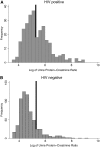HIV and proteinuria in an injection drug user population
- PMID: 20705967
- PMCID: PMC2974385
- DOI: 10.2215/CJN.01030210
HIV and proteinuria in an injection drug user population
Abstract
Background and objectives: Proteinuria is a major determinant of chronic kidney disease. We aimed to characterize the prevalence and correlates of proteinuria in a cohort of HIV-infected and uninfected injection drug users.
Design, setting, participants, & measurements: A cross-sectional analysis was performed among 902 injection drug users (273 HIV-infected) in the AIDS Linked to the Intravenous Experience cohort. The primary outcome was proteinuria defined as having a urine protein/creatinine concentration ratio >200 mg/g. Poisson regression with robust variance was used to determine prevalence ratios.
Results: Overall, 24.8% of participants had proteinuria; the prevalence was 2.9 times higher among HIV-infected participants (45%) compared with HIV-uninfected participants (16%). In addition, age, health insurance, employment status, hepatitis B and C serostatus, diabetes, and high BP were associated with proteinuria. Neither antiretroviral therapy nor features of illicit drug use history were associated with proteinuria. In multivariate analysis, HIV infection, unemployment, increased age, diabetes, hepatitis C infection, and high BP were significantly associated with a higher prevalence of proteinuria.
Conclusions: In an aging, predominantly African-American cohort of injection drug users, we found a striking burden of proteinuria that was strongly associated with HIV status. In addition to being a pathway to ESRD, proteinuria is a potent risk factor for cardiovascular morbidity and mortality. Evaluation of aggressive screening and disease-modification strategies in this high-risk population is warranted.
Figures
References
-
- Winston J, Deray G, Hawkins T, Szczech L, Wyatt C, Young B: Kidney disease in patients with HIV infection and AIDS. Clin Infect Dis 47: 1449–1457, 2008 - PubMed
-
- Deeks SG, Phillips AN: HIV Infection, antiretroviral treatment, aging, and non-AIDS related morbidity. BMJ 338: 288–292, 2009 - PubMed
-
- Gupta SK, Eustace JA, Winston JA, Boydstun II, Ahuja TS, Rodriquez RA, Tashima KT, Roland M, Franceschini N, Palella FJ, Lennox JL, Klotman PE, Nachman SA, Hall SD, Szczech LA: Guidelines for the management of chronic kidney disease in HIV-infected patients: Recommendations of the HIV Medicine Association of the Infectious Diseases Society of America. Clin Infect Dis 40: 1559–1585, 2005 - PubMed
-
- Campbell LJ, Ibrahim F, Fisher M, Holt SG, Hendry BM, Post FA: Spectrum of chronic kidney disease in HIV-infected patients. HIV Med 10: 329–336, 2009 - PubMed
-
- Fine DM, Garg N, Haas M, Rahman MH, Lucas GM, Scheel PJ, Atta MG: Cocaine use and hypertensive renal changes in HIV-infected individuals. Clin J Am Soc Nephrol 2: 1125–1130, 2007 - PubMed
Publication types
MeSH terms
Substances
Grants and funding
LinkOut - more resources
Full Text Sources
Medical


